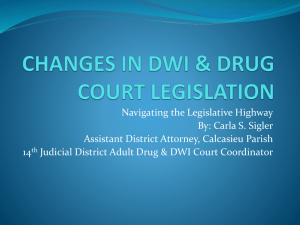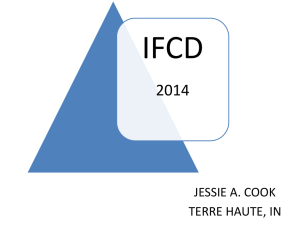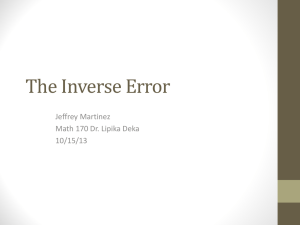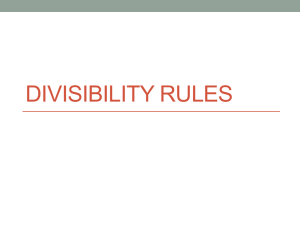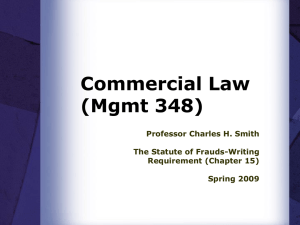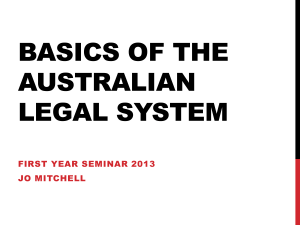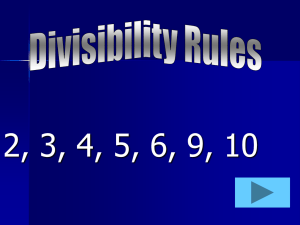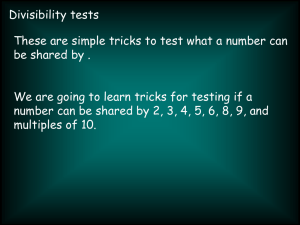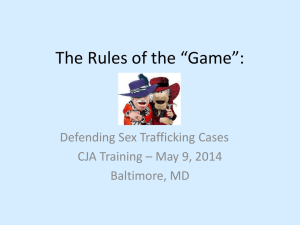Recidivist Enhancements after Descamps PowerPoint
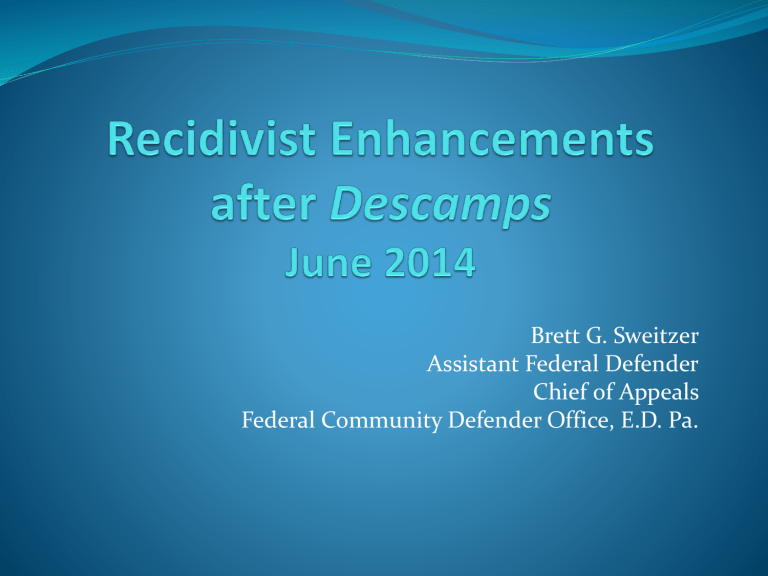
Brett G. Sweitzer
Assistant Federal Defender
Chief of Appeals
Federal Community Defender Office, E.D. Pa.
When Does this Come Up?
Most common situations:
• ∫ 2K2.1:
∫ 4B1.1
crime of violence controlled substance offense
• ∫ 2L1.2: drug trafficking offense crime of violence firearms offense alien smuggling offense aggravated felony
When Does this Come Up?
Most common situations:
• 18 U.S.C. ∫ 924(e): violent felony
∫ 4B1.4
serious drug offense
[priors do not time-out]
• 8 U.S.C. ∫ 1326(b): aggravated felony
Quick Review
Was defendant convicted of ___________?
· focus is on the statute of conviction
NOT
Did defendant commit ____________?
· focus is on the conduct
• Admissions to qualifying conduct are irrelevant
(even in PSRs– but don’t do it)!
• “Of course he did it” is irrelevant
Quick Review
Formal Categorical Approach
· look to statutory definition, not facts
· elements and nature of statute of conviction
· is statute broader than generic crime in enhancement provision? (“least culpable”)
-if yes: never a predicate
-if no: always a predicate
Quick Review
Modified Categorical Approach
· WHEN DO WE GO THERE?
NOT whenever the statute is overbroad
-MCA is not about mining the
Shepard documents for evidence of conduct or “basis of conviction”
-Rather, it’s about identifying the statute of conviction
Quick Review
Modified Categorical Approach
· WHEN DO WE GO THERE?
ONLY when:
(1) statute is divisible into alternative
elements and judgment has general reference
OR
(2) enhancement provision “invites further inquiry”
Quick Review
Modified Categorical Approach
· WHAT IS IT?
look at Shepard/Taylor documents to see if defendant was necessarily convicted of generic crime in enhancement provision
NOT to see what defendant “actually did”
Quick Review
Modified Categorical Approach
• WHAT ARE THE SHEPARD DOCS?
PLUS
TRIAL:
(1) charging document
-information/indictment
-maybe criminal complaint, but not applications and the like
(2) jury instructions
Quick Review
Modified Categorical Approach
• WHAT ARE THE SHEPARD DOCS?
PLUS
PLEA:
(1) charging document
(2) plea agreement/colloquy
OR
(3) other comparable judicial records of sufficient reliability
Quick Review
Modified Categorical Approach
• WHAT ARE THE SHEPARD DOCS?
The “Comparable Records” Loophole:
--limited to judicial docs
--never a certification requirement
--DP standard
• dockets/sent records
• ONLY for SOC, NOT FACTS!
Step One
Identify the Enhancement Provision
∙ “has as an element . . .”
∙ enumerated offenses
MUST DETERMINE GENERIC VERSION
-- CL, MPC, majority state law, and analogous federal law
∙ residual provisions
-- comparative analysis (Begay/Sykes)
Common Step-One Mistakes
“Burglary” = “Burglary”: Failure to Go Generic
EXAMPLE: 2L1.2 COV
• generic “statutory rape”: under 16 y/o; 4-yr delta
“That’s risky”: Failure to compare (purposeful/viol)
EXAMPLE: 4B1.2 COV
∙ reckless/negl simple assault
Step Two
Identify the ELEMENTS of the statute of conviction, and determine if offense is broader than defined/generic offense
•
• identify SOC from conviction record or through modified categorical approach if general reference to divisible statute is there a way to violate statute that would not violate generic offense? (“least culpable”)
-- may be obvious from text of statute or may need to look at state case law (Remember: use the version of the stat in effect when prior committed!)
Common Step-Two Mistakes
• Using modified categorical approach to determine what defendant did, rather than to identify SOC
• Misreading statute/statutory scheme
EXAMPLES:
• failing to review expansive stat language
• failing to look at definitional sections
• failing to look at immigration cases and other jurisdictions
Holding of Descamps
133 S. Ct. 2276 (2013)
• MCA applies ONLY to “divisible” statutes, and
ONLY to determine which division of the statute defendant was convicted under
· MCA DOES NOT apply to overbroad statutes, or to those missing an element of the defined/generic offense altogether
· MCA is tool for implementing CA, not invitation to consider whatever facts are in Shepard documents
Impact of Descamps
Gov’t: None! Third Cir always limited MCA to divisible statutes
Actually: New definition of “divisible”
Old Divisibility: divisible = written in the disjunctive
(list or outline form)
-- PA burglary’s “building or occupied structure”
-- PA simple assault’s “intentional, knowing, or reckless” bodily injury
Impact of Descamps
Actually: New definition of “divisible”
New Divisibility: divisible = separable into alternative elements
-- Determined as a matter of the substantive law of the jurisdiction of conviction
-- Disjunctive statutes NOT divisible if the things listed are simply alternative means of satisfying a single element, rather than alternative elements
-- TEST: whether juror unanimity required
Means or Elements?
How to tell the difference
(1) Look at charging document
-- if charges whole list, they are means and MCA does not apply (Descamps FN 2)
-- doesn’t matter what D admits
(2) If charging document narrows list, look at
governing substantive law regarding submission to jury and juror unanimity
Post-Descamps Cases
•
Third Circuit is Adrift
The Good:
∙ US v. Jones, 740 F.3d 127 (3d Cir. 2014)
-- recognizes MCA use may need to be narrowed in Third Cir
∙ Rojas v. Att’y Gen., 728 F.3d 203 (3d Cir. 2013)
-- MCA does not fill factual gaps
∙ Bautista v. Att’y Gen., 744 F.3d 54 (3d Cir. 2014)
-- no alt elements in disjunctive NY arson
Post-Descamps Cases
• Third Circuit is Adrift
The Bad:
∙ US v. Marrero, 743 F.3d 389 (3d Cir. 2014)
-- PA simple assault divisible because disjunctive
-- looks to plea colloquy for facts
-- PFR en banc den’d; PFC forthcoming
The Neutral:
∙ US v. Abbott, 748 F.3d 154 (3d Cir. 2014)
-- PA PWID divisible because Apprendi element and charging document specified cocaine

